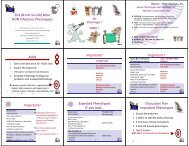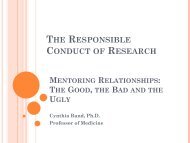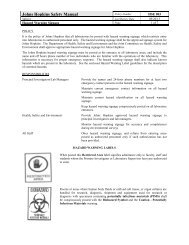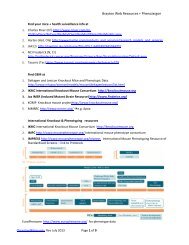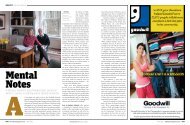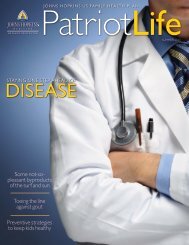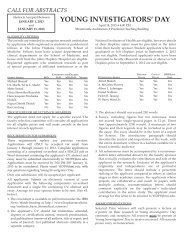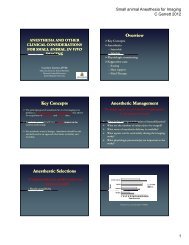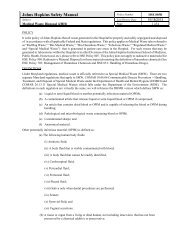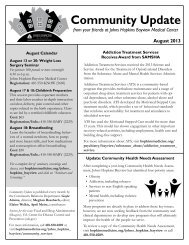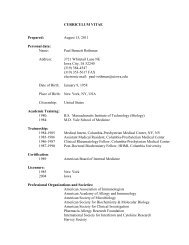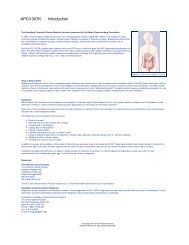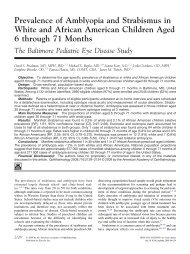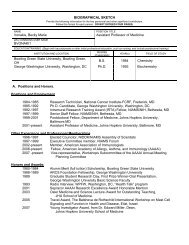Blood Coagulation and Thrombophilia
Blood Coagulation and Thrombophilia
Blood Coagulation and Thrombophilia
Create successful ePaper yourself
Turn your PDF publications into a flip-book with our unique Google optimized e-Paper software.
<strong>Blood</strong> <strong>Coagulation</strong><br />
<strong>and</strong><br />
<strong>Thrombophilia</strong><br />
Cliff Takemoto M.D.<br />
Pediatric Hematology<br />
The Johns Hopkins University
Disclosure Information<br />
Cliff Takemoto MD<br />
NONE
Objectives<br />
•Develop a framework to underst<strong>and</strong> coagulation<br />
•Know how to approach coagulopathies
What is in a clot?<br />
Platelets<br />
www.junebughunter.net<br />
Fibrin<br />
(coagulation proteins)<br />
VENOUS<br />
Slow flow<br />
RED-(rbc’s)<br />
www.uphs.upenn.edu<br />
ARTERIAL<br />
Fast flow<br />
WHITE (plts)
How we clot<br />
Cut in the<br />
endothelium<br />
Exposes collagen for platelet binding sites<br />
Exposes tissue factor for activating coagulation<br />
TF<br />
collagen vWF fibrinogen<br />
collagen<br />
TF TF TF<br />
collagen fibrinogen<br />
vWF vWF<br />
TF<br />
TF TF<br />
collagen vWF<br />
Thrombin<br />
Activation<br />
And fibrin<br />
deposition<br />
Platelet Activation<br />
Platelet granule secretion<br />
Activate fibrinogen receptor<br />
Provides site for prothrombinase complex
This is how a clot is made<br />
platelets fibrin Tissue factor<br />
Falati et al., Nature Medicine 2002 with permission from Nature Publishing Group
how a clot is made in vivo<br />
Thrombin activation INITIATED by TISSUE FACTOR<br />
(microparticles?)<br />
TWO pathways to PLATLET ACTIVATION:<br />
TF (thrombin)<br />
Collagen (vWF)
<strong>Coagulation</strong> Cascades<br />
… the often-asked question: “Why is coagulation so complicated?”<br />
resolves itself into the question: “Why are there so many stages?”<br />
R.G. Macfarlane, Nature 1964<br />
John Hagemen<br />
Rosenthal syndrome<br />
Stephen Christmas<br />
Antti-hemophilc factor<br />
proconvertin<br />
Rufus Stuart<br />
proaccelerin<br />
prothrombin<br />
fibrinogen
<strong>Coagulation</strong> Cascades<br />
Some concepts to remember…<br />
•Highly regulated complexes of<br />
serine proteases <strong>and</strong> co-factors<br />
•All paths lead to thrombin activation<br />
thrombin<br />
•Goal is to make a fibrin clot<br />
fibrin<br />
•They are not just a number—<br />
•they have a personality too!!!<br />
www.uphs.upenn.edu
Serine Proteases<br />
Co-Factors<br />
FIX<br />
FVIII<br />
procoagulant<br />
FX<br />
FVII<br />
FV<br />
TF<br />
anticoagulant<br />
FII<br />
PC<br />
TM<br />
PS
Clot formation--physiology<br />
CONTACT FACTORS<br />
(prekallikrein,HMWK, XII,XI)<br />
Know the functions <strong>and</strong> mechanism of<br />
activation of factor___ in coagulation<br />
intrinsic<br />
tenase<br />
IXa<br />
VIIIa<br />
Ca ++ , PL<br />
“Prothrombinase”<br />
Xa<br />
VIIa<br />
TF<br />
extrinsic<br />
tenase<br />
SERINE PROTEASE<br />
COFACTOR<br />
II<br />
Va<br />
Ca ++ ,<br />
PL<br />
IIa<br />
Fibrinogen<br />
prothrombin<br />
thrombin<br />
Fibrin<br />
polymers
CONTACT FACTORS<br />
(prekallikrein,HMWK, XII,XI)<br />
Clot formation--physiology<br />
PTT<br />
PT<br />
intrinsic<br />
tenase<br />
IXa<br />
VIIIa<br />
Ca ++ , PL<br />
“Prothrombinase”<br />
Xa<br />
VIIa<br />
TF<br />
extrinsic<br />
tenase<br />
Know the<br />
consequences<br />
of deficiency of<br />
factor___ on<br />
the laboratory<br />
assessment of<br />
hemostasis<br />
II<br />
fibrinogen<br />
Va<br />
Ca ++ ,<br />
PL<br />
IIa<br />
Fibrin clot
Clot formation--physiology<br />
CONTACT FACTORS<br />
(prekallikrein,HMWK, XII,XI)<br />
IXa<br />
VIIIa<br />
“Prothrombinase”<br />
Xa<br />
INITIATION<br />
VIIa<br />
TF<br />
AMPLIFICATION<br />
PROPAGATION<br />
II<br />
Va<br />
IIa<br />
fibrinogen<br />
Fibrin clot
Clot formation--physiology<br />
initiation<br />
propagation<br />
IXa<br />
VIIIa<br />
Xa<br />
Va<br />
VIIa<br />
X<br />
TF<br />
II<br />
fibrinogen<br />
IIa<br />
Fibrin clot
Activation of thrombin: 3 complexes<br />
enzyme complexes : protease<br />
cofactor<br />
Prothrombinase Xa Va<br />
Intrinsic tenase IXa VIIIa<br />
Extrinsic tenase VIIa TF<br />
Also need Calcium <strong>and</strong> a phosholipid surface
A few words about contact activation…<br />
•Regulate Inflammation<br />
•HK, PK, FXII deficiency<br />
do not bleed<br />
Protease<br />
Prekallikrein (PK)<br />
FXII<br />
FXI<br />
C1<br />
inh<br />
Inibitor<br />
C1 esterase inhibitor<br />
•FXI deficiency associated<br />
with bleeding<br />
Cofactor<br />
High Molecular-Weight Kininogen (HK)
Thrombin has both pro- <strong>and</strong> anti-coagulant functions<br />
Thrombin<br />
IIa<br />
Fibrinogen<br />
FV, FVIII, FXI<br />
FXIII<br />
TAFI (fibrinolysis inhibitor)<br />
Platelet Activation<br />
procoagulant<br />
Protein C/S<br />
bound to Thrombomodulin<br />
anticoagulant
Fibrinogen Structure<br />
Know basic structure of fibrinogen <strong>and</strong> its gene control<br />
Fibrinogen (soluble)<br />
Fibrin (insoluble)<br />
Fibrinogen Genes<br />
6 polypeptide chains<br />
3 genes: <br />
Gorkun O. et al., <strong>Blood</strong> 1997; 89:4407-44. With permission from the American Society of Hematology
Fibrin Clot formation <strong>and</strong> fibrinolysis<br />
Thrombin (IIa) A B<br />
fibrinopeptides<br />
fibrinogen<br />
D<br />
E<br />
D<br />
D<br />
E D D E D D E D<br />
D<br />
E D D E D D E D D E D<br />
D<br />
E D D E D D E D<br />
FXIII<br />
D-dimer<br />
plasmin
Plasminogen regulation<br />
Activators<br />
t-PA, u-PA<br />
Inhibitors<br />
PAI-1, PAI-2<br />
2 antiplasmin<br />
2 macroglobulin<br />
TAFI
Endogenous Anticoagulants:<br />
Turning off the clot<br />
Protein C<br />
Protein S<br />
Antithrombin<br />
TFPI<br />
VIIIa, Va (the cofactors)<br />
IIa, Xa (serine proteases)<br />
VIIa/TF
How to stop the clot<br />
IXa<br />
TFPI<br />
VIIIa<br />
VIIa<br />
Xa<br />
Va<br />
Protein C<br />
Protein S<br />
IIa<br />
II<br />
IIa<br />
AT III<br />
thrombomodulin
Heparin—physical characteristics<br />
It binds to Antithrombin<br />
heparin<br />
pentasaccharide<br />
binding<br />
to antithrombin<br />
Activation loop<br />
binds to reactive<br />
Site in serine<br />
protease
Heparin-- physical characteristics<br />
Pentasacchride Antithrombin<br />
binding sequence<br />
From the Wallstreet jounal
Heparin binds <strong>and</strong> activates Antithrombin<br />
<strong>Coagulation</strong> Factors<br />
Suicide inhibitor<br />
ATIII<br />
IIa<br />
Xa<br />
Heparin accelerates this reaction >1000fold<br />
ATIII<br />
IIa<br />
Xa<br />
Pentasacchride sequence of heparin binds antithrombin
Antithrombin Deficiency<br />
• Prevalence 1/5000<br />
• Risk of thrombosis <br />
15-20X<br />
IIa<br />
Xa<br />
XIa<br />
• Acquired formsnephrotic<br />
syndrome,<br />
liver disease<br />
IXa<br />
AT III<br />
heparin<br />
• Lab- Antithrombin<br />
activity<br />
IXi<br />
IIi<br />
Xi<br />
XIi
Protein C <strong>and</strong> Protein S<br />
Vitamin K dependent<br />
Protein C-serine protease<br />
Protein S-cofactor<br />
Activated by thrombin/TM<br />
VIIIa<br />
Va<br />
cofactors<br />
IIa<br />
C<br />
APC<br />
C4b binding protein<br />
Thrombomodulin<br />
S<br />
S
Protein C <strong>and</strong> S deficiency<br />
• Protein C- 1/250-500<br />
• Protein S- 1/1000<br />
• Increase risk 5-10X<br />
• Acquired causes:<br />
Both: Vit. K deficiency<br />
Protein S: estrogens,<br />
pregnancy<br />
• Homozygous protein C<br />
presents with neonatal purpura<br />
fulminans<br />
• Lab- Protein C <strong>and</strong> S activity<br />
C4bBP<br />
S<br />
S<br />
C<br />
T<br />
VIIIa<br />
Va<br />
TM<br />
APC<br />
S<br />
VIIIi<br />
Vi
Thromboembolic events with other prothrombotic risk factors
Factor V Leiden<br />
• Prevalence 5% (0-15%)<br />
• Autosomal dominant<br />
• Prevents inactivation of FVa<br />
• Thrombosis risk:<br />
• FVL +/- = 5X<br />
• FVL+/+ = 50X<br />
• FVL +/- <strong>and</strong> OCPs = 30X<br />
306 506 679<br />
Factor Va<br />
APC<br />
Factor Vi
What is APC resistance?<br />
PTT (APC)<br />
PTT<br />
normal:<br />
75sec<br />
30sec<br />
= 2.5<br />
FVL:<br />
39 sec<br />
30 sec<br />
= 1.3<br />
Arg 306 Arg 506<br />
Arg 679<br />
FVa<br />
R506Q is the FV leiden mutation
Characteristics of Clotting Factors<br />
Factor Invivo T 1/2 Synthesis Function vitK<br />
Fibrinogen (I) 2-4 days liver -<br />
Prothrombin (II) 3 days liver SP +<br />
V 36 hrs liver/(mega) CoF -<br />
VII 3-6 hrs liver SP +<br />
VIII 8-12 hrs liver/EC CoF -<br />
IX 22 hrs liver SP +<br />
X 40 hrs liver SP +<br />
XI 80 hrs liver SP -<br />
XII 50-70 hrs liver SP -<br />
XIII 10 days liver/M TG -<br />
VWF<br />
12 hrs EC/(mega)<br />
mega—megakaryocyte; M—macrophage; EC—endothelial cell; SP—serine<br />
protease; CoF—Cofactor;TG--transglutaminase<br />
Coleman Hemostasis <strong>and</strong> Thrombosis 3 rd Edition
Characteristics of Clotting Factors<br />
Factor Incidence Inheritance<br />
Fibrinogen (I)<br />
1:1 million afibrinogen-recessive<br />
hypofibrinogen-dominant<br />
Prothrombin (II) 1:2 million recessive<br />
V<br />
1:1 million recessive<br />
VII<br />
1:300,000 recessive<br />
VIII 1:5,000 x-linked<br />
IX 1:30,000 x-linked<br />
X<br />
1:1 million recessive<br />
XI<br />
1:1 million recessive<br />
1:12 (het) Ashekenazi Jewish<br />
XII 1:50 (het) recessive<br />
XIII<br />
1:1 million recessive<br />
VWF 1:100 Type 1 dominant<br />
1:1 million Type 3 recessive<br />
Bolton-Maggs et. al., Haemophilia 2004
Approach to abnormal laboratory screens<br />
Elevated aPTT<br />
Elevated PT<br />
Elevated aPTT <strong>and</strong> PT<br />
Elevated<br />
Thrombin Time
Elevated aPTT<br />
Mixing study<br />
1:1 ratio<br />
control + patient plasma<br />
correction<br />
no correction<br />
Bleeding<br />
FVIII<br />
FIX<br />
FXI<br />
No Bleeding<br />
Heparin Circulating Inhibitor<br />
Contact factors<br />
--FXII<br />
--PK Phospholipid dependent<br />
--HMWK Lupus Anticoagulant<br />
Non-specific<br />
--DRVVT<br />
--phospholipid neutralization<br />
--platelet neutralization
Elevated aPTT <strong>and</strong> PT<br />
Thrombin Time<br />
Fibrinogen activity<br />
Prolonged<br />
Normal<br />
Low<br />
Heparin<br />
FDP (DIC)<br />
Fibrinogen<br />
Factor Deficiencies<br />
Common Pathway<br />
--FV, FX<br />
Combined Pathway<br />
--Intrinsic/Extrinsic<br />
--vitamin K deficiency<br />
Aquired<br />
Liver disease<br />
DIC<br />
Inherited<br />
FGN ag low/absent<br />
--hypofibrinogenemia<br />
--afibrinogenemia<br />
FGN ag normal<br />
--dysfibrinogenemia<br />
Thrombin Time--prolonged<br />
Reptilase Time--normal<br />
heparin<br />
Thrombin Time--prolonged<br />
Reptilase Time--prolonged<br />
Low fibrinogen<br />
dysfibrinogenemia
Case<br />
23 year old male with hemoptysis for 3 weeks<br />
Seen at Eastern Shore ER <strong>and</strong> spiral CT shows large PE<br />
Transport Team calls you—asks for<br />
management advice <strong>and</strong> recommendation<br />
for bloodwork before treatment?
Case<br />
Antithrombin, protein C/S, APC, prothrombin 20210,<br />
Homocysteine, etc—all normal.<br />
One test you were not able to get was the<br />
antiphospholipid antibodies. He is already<br />
on heparin. When can you do the test?<br />
Does it matter?
Case<br />
RVVT: 74 (27-45)<br />
1:1 mix 56.2 (27-45)<br />
4:1 mix 65.3 (27-45)<br />
aPTT 30 (24-34)<br />
PT 10.9 (10.4-12.0)<br />
RVVT:confirm 1.8 (1-1.4)<br />
ratio<br />
DRVVT was tested on coumadin <strong>and</strong> prolonged.<br />
The “confirm ratio” was high, suggesting<br />
an antiphospholipid antibody
Antiphospholipid antibodies (APA)<br />
Lupus Anticoagulant<br />
prolong PTT test AND is phospholipid dependent<br />
(mixing study with plt neutralization, DRVVT)<br />
--usually benign <strong>and</strong> transient<br />
--can be seen in association with thrombosis<br />
--bleeding when directed against specific factor<br />
(FII, FV, FVIII)<br />
--can be acquired transaplacentally in neonates<br />
Anticardiolipin Antibodies<br />
ELISA based detection<br />
Anti-Beta2 Glycoprotein I Antibodies<br />
ELISA based detection<br />
ACA<br />
LA<br />
B2GPI
Dilute Russell viper venom time<br />
(DRVVT—like aPTT)<br />
•Activate X<br />
•Sensitive to inhibition by<br />
Antiphospholipid Ab<br />
X<br />
Confirm Ratio<br />
dRVVT (sec)<br />
dRVVT + PL (sec)<br />
Xa Va II IIa<br />
Normal<br />
60 sec.<br />
30 sec.<br />
(1 - 1.4)<br />
= 2<br />
If the confirm ratio is high<br />
An a phospholipid ab is present
Case 1<br />
21 year old woman with history of short gut<br />
syndrome due to small bowel atresia presents<br />
with fever, renal insufficiency <strong>and</strong> jaundice<br />
WBC: 18K/cu mm<br />
H/H: 9.9 g/dl/29.3%<br />
Plt: 132K/cu mm<br />
aPTT/PT:<br />
62 s/ 19 s<br />
ALT: 144 U/L<br />
AST: 666 U/L<br />
Bilirubin 6.2 mg/dl<br />
Direct bilirubin 1.0 mg/dl<br />
Fibrinogen: 150 mg/dl<br />
D-dimer: 21 mg/L
Case 1<br />
FV 14%<br />
FVII 29%<br />
FVIII 138%<br />
Diagnosis?<br />
Coagulopathy of Liver Disease
Case 2<br />
6 week infant with presents with lethargy,<br />
bulging fontelle<br />
On examination, extensive bruising,<br />
bleeding from the mouth
Case 2<br />
WBC: 10.9K/cu mm<br />
H/H: 7.8 g/dl 22.2%<br />
Plt: 407K/cu mm<br />
aPTT/PT:<br />
>100 s/ 65 s<br />
Fibrinogen: 360 mg/dl<br />
D-dimer: > 2.6 mg/L
Case 2<br />
FII 3%<br />
FV 108%<br />
FVII 4%<br />
FVIII 132%<br />
FIX 2%<br />
FX 1%<br />
Diagnosis?<br />
Late Vitamin K Deficiency Bleeding<br />
(VKDB)<br />
Management?<br />
FFP<br />
IV vitamin K
Vitamin K metabolism<br />
Ca++<br />
Active Factors<br />
Bind to Phopholipid<br />
surface<br />
Vitamin K Dependent Factors<br />
II<br />
VII<br />
IX<br />
X<br />
Protein C<br />
Protein S<br />
Gla proteins<br />
osteocalcin<br />
(bone)
Case 3<br />
17 old male with presents with bruising <strong>and</strong><br />
Petechia<br />
WBC:10.9K/cu mm<br />
H/H: 7.8 g/dl 22.2%<br />
Plt: 17K/cu mm<br />
Blasts on peripheral smear<br />
Fibrinogen: 112 mg/dl<br />
D-dimer: > 54.7 mg/L<br />
aPTT/PT:<br />
40s/19 s
Flow<br />
APML<br />
normal
Case 3<br />
Diagnosis:<br />
Acute Promyelocytic Leukemia<br />
With DIC
Concepts about the pathophysiology of DIC:<br />
microvascular clotting<br />
Underlying disease<br />
Activation of coagulation<br />
Depression of<br />
Anticoagulant proteins<br />
impaired fibrinolysis<br />
Consumption of<br />
<strong>Coagulation</strong> factors<br />
<strong>and</strong> platelets<br />
Fibrin deposition<br />
Microvascular thrombosis<br />
Severe Bleeding
Anticoagulant <strong>and</strong> Procoagulant<br />
Proteins are low in DIC<br />
TFPI<br />
Protein C/S<br />
Antithrombin<br />
Factors<br />
platelets<br />
Anti-coagulant proteins<br />
Clotting<br />
Procoagulant proteins<br />
Bleeding<br />
BUT:<br />
Organ failure principally arises from microvascular clotting
Diagnosing DIC<br />
No single test<br />
Scoring Criteria for diagnosis <strong>and</strong> managment<br />
• Thrombocytopenia<br />
• Elevated D-dimers/FSP (sensitive)<br />
• Low fibrinogen (late finding)<br />
• Elevated PT (PT more sensitive than aPTT)
Pathogenesis of DIC<br />
Microvascular fibirn deposition<br />
Leads to organ dysfunction<br />
1. Tissue Factor initiation of coagulation<br />
from monocytes, other cells<br />
2. Decreased anticoagulants leading to<br />
uncontrolled amplification of thrombin<br />
3. Fibrinolysis accompanies DIC but is impaired<br />
due to upregulation of PAI with fibrin<br />
propagation
Treatment of DIC<br />
• Treat underlying disease<br />
• Coagulopathy? Treat bleeding/bleeding risk<br />
• No consensus guidelines for transfusion with platelets,<br />
FFP, cryoprecipitate<br />
• Role for anticoagulants?
Distinguishing coagulopathies<br />
FVII<br />
Liver DIC vitamin K<br />
FV<br />
FVIII<br />
NL or<br />
NL<br />
NL
Coagulopathy in other acquired disorders<br />
Hemophagocytic syndromes—DIC with hypofibrinogenemia<br />
Leukemia—DIC (APML); platelet dysfunction (M7, M5 AML)<br />
L-Asparaginase—impaired protein synthesis with hemorrhage <strong>and</strong><br />
thrombosis; AT deficiency<br />
Nephrotic Syndrome—loss of coagulation factors with thrombosis; AT<br />
deficiency
Bleeding in Renal Disease<br />
Platelet dysfunction<br />
--Uremia<br />
--Increased nitric oxide production<br />
--Anemia<br />
Treatment<br />
--dialysis<br />
--RBC Txn; plt Txn<br />
--DDAVP; cryoprecipitate<br />
--conjugated estrogens
Summary<br />
•Function: Serine Protease or CoFactor<br />
•Except FXIII transglutaminase<br />
•Site of synthesis: Liver<br />
•FVIII liver+endothelium; vWF endothelium<br />
•FXIII liver+Macrophage; FV liver+megakaryocyte<br />
•Consequence of deficiency: Bleeding<br />
•Except for most Contact Factors<br />
•Half life: FVII 2hrs; FXIII 2 weeks
Summary<br />
•Work up for PTT/PT elevation:<br />
•Liver coagulopathy—FVIII preserved<br />
•Vitamin K deficiency<br />
•DIC—anticoagulant <strong>and</strong> procoagulant low



